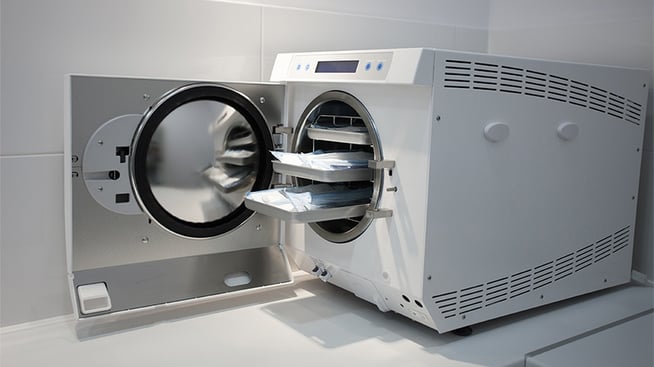Manufacturing cable assemblies used in precision medical device applications requires rigorous demands just to meet the industry standard. When dealing with these specific applications, failure is not an option. Envision applications used in a medical environment. You must limit the possibility of failure for users in the field. Even something as mundane as cable sterilization can potentially cause the cable to fail and/or cause issues for the user(s).
In general, sterilization is the process that eliminates or kills all biological agents (bacteria, viruses, etc.). Now there are a few techniques worth mentioning in which manufactures of medical cable assemblies can take to ensure ultimate sterilization when the requirement is critical.

Autoclave for Sterilizing Medical Equipment
Steam Heat Sterilization
One technique is to use a device called an autoclave, essentially a large and highly concentrated chamber, which exposes whatever is inside to extreme temperature and/or chemical reactions. In this particular case it is used for steam sterilization. The steam under pressure acts as the sterilization agent with heat reaching temperatures as high as 134°C lasting up to 20 minutes depending on load size. Before the cable assembly receives the heat treatment all air is removed from the chamber for added protection. It is important to take note that this technique will not work for all materials, such as plastics.
Compatible Plastics Used in Steam Heat Sterilization
- Polypropylene
- Polypropylene Copolymers
- High Heat Polycarbonates
- Acetals
Dry Heat Sterilization
Dry heat technique is usually the first choice in attempting sterilization. Giant ovens are used to generate heat with temperatures reaching 160°C with duration of two hours or 170°C with duration of one hour. The entire item reaches proper temperature by heat absorption when the exterior surface passes heat inward. The downside to this method is again material limitations.
Compatible Plastics Used in Dry Heat Sterilization
- High Heat Polycarbonates
- Acetals
Dry Heat vs Steam Heat Sterilization
There are similarities and differences between both sterilization techniques. You can expect similar results when dealing with glassware and most metal instruments. What separates each method is the capacity of the material involved. See below for more details on best use for each approach.
Steam Heat Sterilization
- Culture Material
- Flammable and Heat-Sensitive Items
- Liquids
- Dense Loads
- More Efficient Than Dry Heat
Dry Heat Sterilization
- Hydrophobic Materials (Fats, Oils, Powders)
- Corrosive Materials
Ethylene Oxide (EO) Sterilization
Another technique for sterilization is Ethylene Oxide or more commonly known as EO. What is the most different about this method is that instead of using heat to complete the sterilization this is a chemical process. For an example gas is released, the gas would then be exposed to the intended part(s) causing sterilization reaction. This is a particularly good way for sterilization if the application cannot be exposed to high temperatures and/or moisture. Another positive in using EO is that the gas is capable of penetrating packaging and products while still managing to kill microorganisms. Most materials would be capable of using this process to reach sterilization.
Radiation Sterilization
An additional process is done through radiation. Using either gamma rays or an electron beam will sterilize the application. All components of the device are sterilized at the same time. There is no need for pressure, high heat, or moisture, keeping the packaging intact. Typically, you will find this method to be used in single use/disposable products. A positive aspect of this is the ability for dosimetric release which simply means the product is available for immediate release. Some of the high heat processes require a cool down period. With radiation there is nothing to be concerned about as far as residue or heat factor.
Compatible Plastics Used in Radiation Sterilization
- Polyesters
- Polyethylenes
- PVC (Plasticized)
- Polyurethanes
Summary
In a basic context, consider steam heat as a pressure cooker, dry heat as a conventional oven, and gamma radiation similar to a microwave. Regardless of which of the cable assembly sterilization techniques best meets your application, each is intended for ensuring complete sterilization.
Key Takeaways
- Different sterilization methods suit different materials: Steam heat, dry heat, ethylene oxide (EO), and radiation sterilization each have their own compatibility limitations and advantages depending on the cable assembly’s materials.
- Steam heat sterilization is efficient, but harsh: Autoclaving offers fast and effective sterilization using high-pressure steam, but not all plastics can withstand the heat and moisture.
- Dry heat sterilization is ideal for moisture-sensitive components: It avoids steam but requires longer exposure at higher temperatures and is limited to heat-tolerant materials like polycarbonates and acetals.
- Ethylene oxide (EO) is effective for sensitive or complex assemblies: This low-temperature chemical process can sterilize through packaging, making it ideal for delicate or mixed-material cable assemblies.
- Radiation sterilization is common for disposables: Using gamma rays or electron beams, this method offers immediate use post-sterilization without affecting packaging, though material compatibility must be considered.















